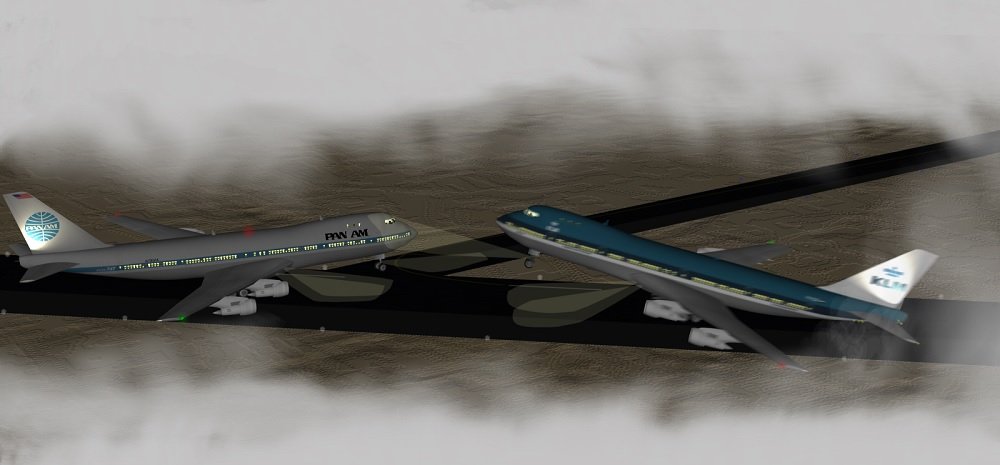Despite both aircraft attempting to avoid each other, with the Pan Am Boeing 747 veering sharply onto the grass and the KLM Boeing 747 pulling up, they were unable to avoid the collision
The 747 was the result of the work of some 50,000 Boeing people. Called “the Incredibles,” these were the construction workers, mechanics, engineers, secretaries and administrators who made aviation history by building the 747 — then the largest civilian airplane in the world — in roughly 16 months during the late 1960s.
The incentive for creating the giant 747 came from reductions in airfares, a surge in air-passenger traffic and increasingly crowded skies.
On Mar. 27, 1977 two Boeing 747s were involved in the deadliest incident in aviation history.
On that day, a KLM Boeing 747 and a Pan Am Boeing 747 collided on the tarmac at the Tenerife Airport, resulting in the deaths of 583 people.
The accident happened when KLM flight 4805, carrying 248 passengers and crew, attempted to take off from the same runway where Pan Am flight 1736, which had 396 people on board, was taxiing.
Due to bad weather, the pilots on the two planes were unable to see each other from a distance and were relying on air traffic control to guide them.
The error was only spotted when the KLM flight was just 2,000ft away from the Pam Am plane – but it was already too late.
Seconds before crashing, Pan Am pilot Victor Grubbs was recorded saying: “Look at him! Goddamn, that son of a bitch is coming!”

Despite both aircraft attempting to avoid each other, with the Pan Am plane veering sharply onto the grass and the KLM Boeing 747 pulling up, they were unable to avoid the collision.
As explained in extensive piece published by The Sun, the KLM aircraft’s undercarriage and engines hit the top of the Pan Am plane at speed, resulting in a catastrophic crash.
Pan Am co-captain Robert Bragg, who died in 2017, told BBC’s Witness in 2016: “When he hit us, it was a very soft boom.
“I then looked up for the fire control handles and that’s when I noticed the top of the aeroplane was gone.”
Robert managed to escape along with 61 lucky passengers.
He explained: “I jumped to the ground, 40 feet from the cockpit and thanked the lord I landed on grass.
“One poor lady jumped first and everyone else jumped on her, broke her back and both legs and both arms.”
After five minutes, the fuel tank blew up, sending flames “250 feet in the air,” as the aircraft fell apart.
The collision of the two planes was attributed to a number of issues.

Earlier that day, a bomb explosion at Gran Canaria Airport that injured eight people, followed by a second bomb threat by the Canary Islands Independence Movement, led to extra planes being diverted to the airport in Tenerife.
With a large number of aircraft landing, the entrance to the main runway was blocked.
It meant that planes were forced to taxi on the runway itself, before making a 180 degree turn to take off.
It was also a foggy day, meaning a much lower visibility for pilots.
Because of this, Pan Am missed their assigned turn off at exit three and taxied to exit four instead, keeping them on the runway for much longer than expected.
However, what were also factored in the final incident report were the key phrases used by pilots and air traffic control which caused confusion and misunderstanding.
The incident report filed in 1977 explained that there was a breakdown in communication due to the ambiguous use of the words “okay” and “take off”, as well as the different accents and languages involved.
The report gives an example of the problem this caused during the incident: “The controller then said, “Okay (pause) stand by for takeoff, I will call you.”
“On the KLM CVR, the portion of this transmission following the word ‘okay’ is overlayed by a high pitched squeal, and the tone of the controller’s voice is somewhat distorted, though understandable.”
The report said: “We believe that nothing after the word ‘okay’ passed the filters of the Dutch crew, thus they believed the controller’s transmission approved their announced action in taking off.”

Pilots are now required to learn “radiotelephony”, also known as Aviation English, which features roughly 300 words and instructions on when and how to use them.
Roger, for example, means message received – but it doesn’t mean the receiver understands the instruction, or that they are planning to comply.
Instead, a pilot might say Roger and then repeat the instruction back to the ATC to make sure both sides are clear on the situation – or they could say Roger and explain why they can’t follow the instruction or if they don’t understand. Pilots only confirm that they will follow the instructions given when they say Wilco (for will comply).
Words that have ambiguous meanings such as “okay”, which could be misinterpreted, are not part of Aviation English.
Another issue that was highlighted was the authority in the cabin – the co-pilot on the KLM flight was relatively junior and didn’t have the authority to challenge the captain’s decisions in the cabin.
So when he highlighted a possible miscommunication, he was ignored by the captain.
Since then, the co-pilots, and even the crew, have been given greater power to challenge the captain’s decisions.
The accident (which was also known as the Tenerife Airport Disaster), the worst of its kind in history, now forms an essential part of a pilot’s training.
The following video is an FAA animation of the Tenerife accident.
Photo by SafetyCard Own work and Anynobody via Wikipedia

